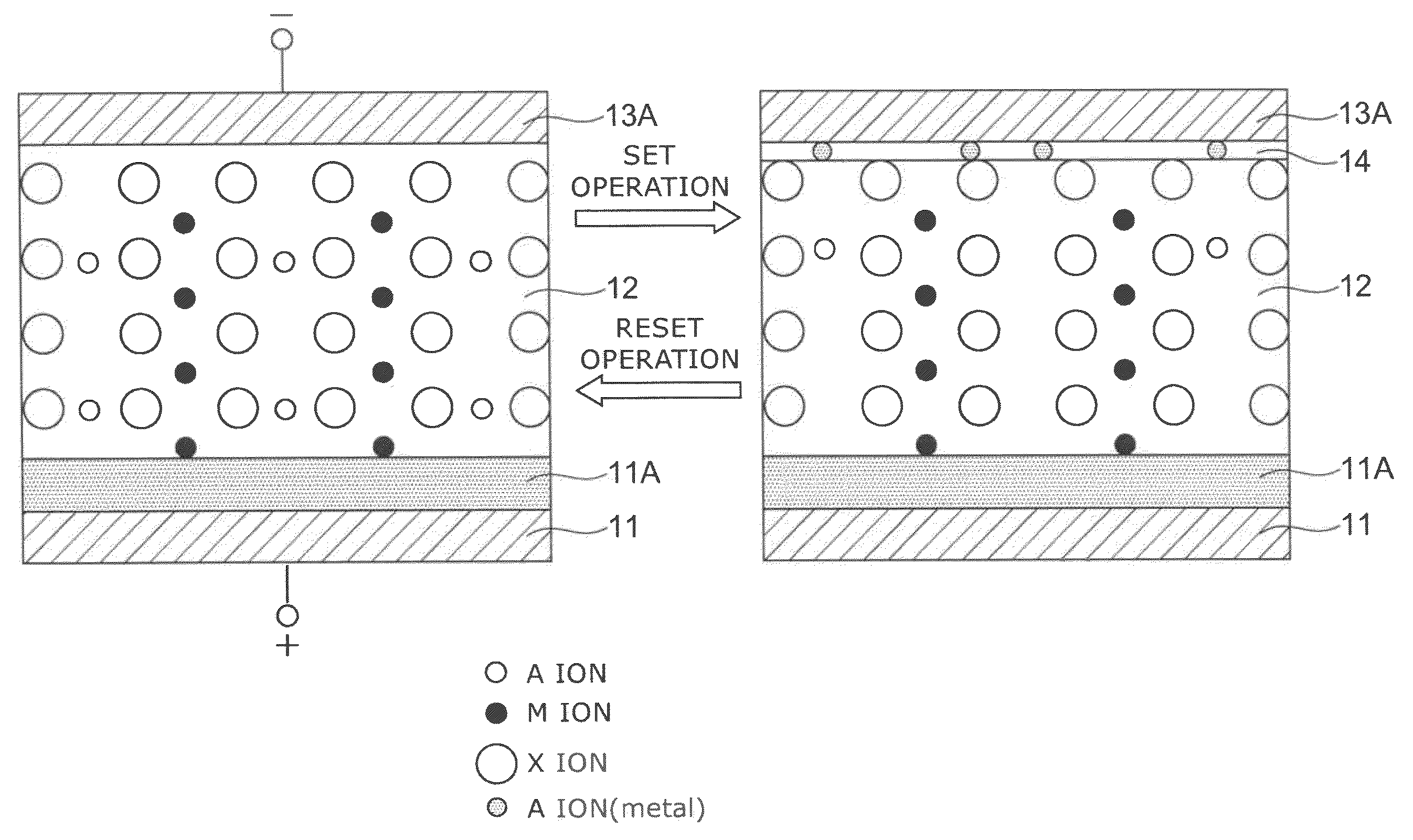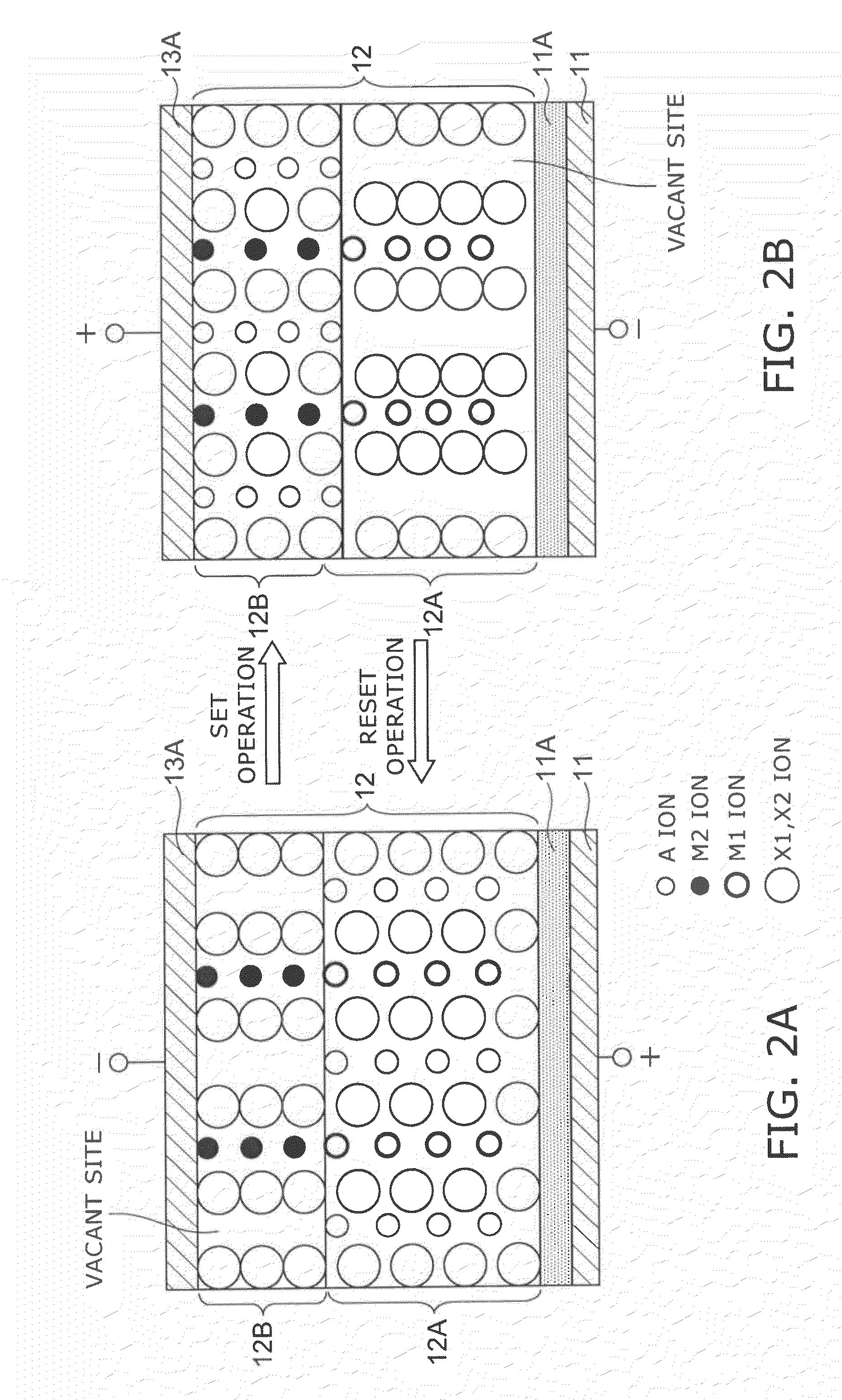Information recording and reproducing apparatus
a technology which is applied in the field of information recording and reproducing apparatus, can solve the problems of unrealized memory recording by such a ferroelectric, undesirable electric field emitted by the recording medium to the outside, and inability to read, etc., and achieves low power consumption and high recording density.
- Summary
- Abstract
- Description
- Claims
- Application Information
AI Technical Summary
Benefits of technology
Problems solved by technology
Method used
Image
Examples
first embodiment
[0100]FIG. 1 is a conceptual view illustrating the basic principle of recording / reproducing information in an information recording and reproducing apparatus according to a first embodiment of the invention.
[0101]FIG. 1A is a cross-sectional view of a recording unit. The recording unit has a structure in which electrode layers 11 and 13A are disposed on either side of a recording layer 12. Further, an orientation control layer 11A is provided between the recording layer 12 and the electrode layer 11.
[0102]The recording layer 12 includes a first compound, where the first compound is a conjugated compound including at least two types of cation elements, at least one selected from the cation elements is a transition element having a d orbit incompletely filled by electrons, and the shortest distance between adjacent cation elements is not more than 0.32 nm. Such a recording layer may include, for example, the following materials.
[0103]One example is a spinel structure represented by Ax...
second embodiment
[0248]Next, the basic principle of recording / erasing / reproducing information in an information recording and reproducing apparatus according to a second embodiment of this embodiment will be described.
[0249]FIG. 2 is a conceptual view illustrating the structure of the recording unit of this embodiment.
[0250]The recording unit has a structure in which the electrode layers 11 and 13A are disposed on either side of the recording layer 12. Further, the orientation control layer 11A is provided between the recording layer 12 and the electrode layer 11.
[0251]The recording layer 12 includes a first compound 12A disposed on the electrode layer 11 side and represented by AxM1yX1z and a second compound 12B disposed on the electrode layer 13A side, including at least one type of transition element, and having vacant sites capable of containing the A ion element of the first compound 12A.
[0252]The second compound 12B may include substances such as those represented by, for example, the followin...
first experimental example
[0470]A first experimental example is an example using (100) oriented VN as the orientation control layer and using ZnCr2O4 as the first compound.
[0471]VN was formed in a film on a B-doped Si (100) substrate using a target (with a diameter of 100 mm) having a composition ratio adjusted to deposit VN. The native oxide film of the Si substrate surface is removed beforehand. Although the orientation differs by the power and the pressure during film formation in the case where VN is formed in a film, in the case of this experimental example, RF magnetron sputtering was performed at room temperature in 0.5 Pa argon gas with an RF power of 100 W; and as a result, (100) oriented VN was obtained. The VN film thickness was 50 nm.
[0472]Continuing, ZnCr2O4 was formed in a film as the first compound without removing the substrate from the vacuum chamber. RF magnetron sputtering was performed in an atmosphere of 95% Ar (argon) and 5% O2 (oxygen) using a target having a mixing ratio adjusted such...
PUM
 Login to View More
Login to View More Abstract
Description
Claims
Application Information
 Login to View More
Login to View More - R&D
- Intellectual Property
- Life Sciences
- Materials
- Tech Scout
- Unparalleled Data Quality
- Higher Quality Content
- 60% Fewer Hallucinations
Browse by: Latest US Patents, China's latest patents, Technical Efficacy Thesaurus, Application Domain, Technology Topic, Popular Technical Reports.
© 2025 PatSnap. All rights reserved.Legal|Privacy policy|Modern Slavery Act Transparency Statement|Sitemap|About US| Contact US: help@patsnap.com



